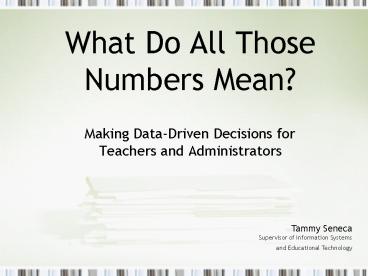What Do All Those Numbers Mean - PowerPoint PPT Presentation
1 / 15
Title:
What Do All Those Numbers Mean
Description:
There are nine stanine units (the term is short for 'standard nine-point scale' ... Using only nine numbers, stanine scoring is usually easier to understand than ... – PowerPoint PPT presentation
Number of Views:82
Avg rating:3.0/5.0
Title: What Do All Those Numbers Mean
1
What Do All Those Numbers Mean?
- Making Data-Driven Decisions for Teachers and
Administrators
Tammy SenecaSupervisor of Information Systems
and Educational Technology
2
What type of data do we need to look at?
- Quantitative
- This type of data deals strictly with numbers.
For example, a standard score on the ITBS or the
LEAP test. - This type of data can also be analyzed by looking
at classroom grades on teacher-generated tests. - Qualitative
- This type of data deals with words. For example,
observations recorded about a student during a
particular situation. - This type of data may also be gathered from
interviews.
3
What do all those numbers represent?
N NumberSS Standard ScoreNS National
StanineNCE National Curve EquivalentNPR
National Percentile Rank
4
What is a Standard Score?
ITBS Standard Scores
5
What is a Stanine?
A stanine is a type of scaled score used in many
norm-referenced standardized tests. There are
nine stanine units (the term is short for
"standard nine-point scale"), ranging from 9 to
1. Typically, stanine scores are interpreted as
above average (9, 8, 7), average (6, 5, 4), and
below average (3, 2, 1). Using only nine numbers,
stanine scoring is usually easier to understand
than other scoring models.
6
National Percentile Rank
- Percentile rank identifies the percentage of a
students peer group (e.g., grade level) that a
students score surpassed. - Percentile rank is useful in comparing an
individual student's performance with those of
other students within a defined group. - For example, a student receives a test score of
66 and a percentile rank of 83. This means that a
score of 66 is higher than 83 of the comparison
group. - Percentiles compares the test taker to a larger
population. - National Average NPR is 50.
7
Types of Data
- Hard Data
- This is data that we would examine from
norm-referenced (ITBS) and criterion-referenced
(LEAP, GEE, and a component of ILEAP) tests. - Norm-referenced tests compare the test taker to a
large norm group or in the case of the ITBS test
the nation. - Criterion-referenced tests compare the test taker
to a small group or populations. In the case of
LEAP and GEE that would be students in the same
grade within the state of Louisiana.
Hard data allows us to examine data for trends in
order to find specific strengths and weaknesses.
8
Finding Trends.
When looking for trends you need to try to find
areas that are supported by data preferably 3
years of it!
For example, what trend do you see occurring in
the mathematics data?
Where do we go from here?
Graphs Handout 1
9
Go to the Subtest Reports Look for Weaknesses
Look at the C Sch. (Percent Correct for the
School) column to begin to narrow down the areas
of strength and weakness. It is always important
to remember that it may not be a true weakness or
strength if there are only a couple of questions
on the test. So you will also want to look at
the Total Items column and No. Att. (Number
Attempted).
10
Trends
Graphs Handout 4
11
(No Transcript)
12
- Soft Data
- This type of data includes a variety of
alternative assessments including
teacher-generated tests. - This data can be analyzed using Microsoft Excel
in much the same may that hard data can. - Example Creating Bar Graphs to post in your
classroom with the results of the chapter test(s).
13
The bar graph below can be printed out and posted
in your classroom.
14
Keep a running analysis of your chapter test and
see if you can find trends or areas that need to
be re-taught.
Do you see a problem brewing?
15
(No Transcript)































